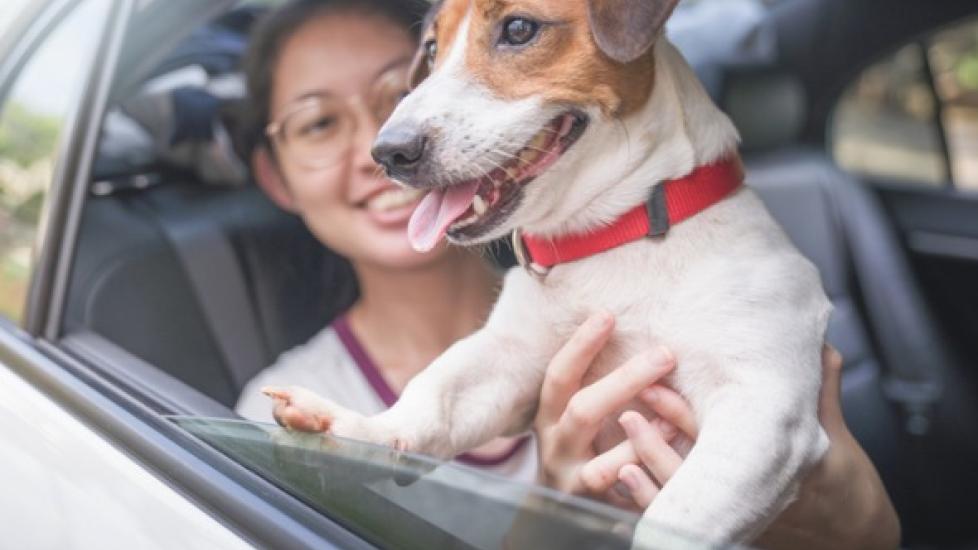COVID-19 and Pets: Should I Go to the Vet or Wait? What’s the Protocol?

By Dr. Katy Nelson, DVM
It’s a scary time right now, and everyone is adjusting to a new normal. During this time of social distancing, we should all be trying to do our part to “flatten the curve” of COVID-19. This means staying home, eating in, and reducing unnecessary contact with others.
While our pets are probably loving this extra cuddle time with us, what do you do if they need to go to the veterinarian?
Many veterinary hospitals are recommending to only come in if your pet is ill, and to postpone any routine visits until a safer time. Some are using telemedicine, where you can connect with your vet through video chat for minor issues or scheduled follow-ups.
This guide will help you determine whether you need to take your pet to the vet now vs. waiting, what to expect, how to prepare, and what to do if your vet is closed.
Should You Take Your Pet to the Vet Now?
With the new practice of social distancing, how do you know if you should bring your pet to your veterinarian today, or if it’s something that can wait?
Here are some helpful tips to ensure you are taking the best possible care of your pet while minimizing the risk to expose you and your pet to COVID-19:
Go to an emergency veterinarian immediately if your pet:
-
Ingested a toxin: human medications, chocolate, xylitol (artificial sweetener), antifreeze, rat poison, raisins, etc. Call poison control immediately at 888-426-4435.
-
Has an open wound
-
Has a history of trauma
-
Is showing signs of pain
-
Is having difficulty breathing
-
Suddenly shows signs of lameness or weakness
-
Is having difficulty urinating (especially cats)
-
Has prolonged vomiting and diarrhea (especially if blood is seen), or any severe distention of the abdomen
-
Shows neurologic signs such as seizures, tremors, stumbling, circling, being disoriented
-
Has an abnormal appearance or behavior, such as pale gums, bruising of the body, bulging eyes, squinting eyes, holding head to one side
-
Has facial swelling or hives
-
(Your cat) has not eaten in more than one day or is looking yellowish (icterus)
Call your veterinarian about coming in if your pet:
-
Has vomited once or twice in 24 hours
-
Has had diarrhea for less than 24 hours but is acting normally
-
Is coughing without signs of labored breathing
-
Is sneezing and has watery eyes
-
Has not eaten for less than 24 hours
-
Is itching or shaking ears
Schedule an appointment later if your pet:
-
Needs annual exams or routine bloodwork
-
Has new lumps or bumps without showing signs of discomfort
-
Has a torn toenail that is not bleeding or causing discomfort
-
Has worms in their stool and/or visible fleas or ticks without having diarrhea or discomfort. In this case, call your veterinarian to ask for a prescription for a dewormer and flea and tick products.
What Do I Do If My Vet Is Closed?
Veterinary services have been deemed “essential” by the federal government, but this does not mean that they are required to stay open.
The essential designation means that veterinary hospitals are not ordered to close as many other businesses have been. If your local hospital is unable to establish protocols that allow them to practice safely, they may choose to close.
If your veterinarian has decided to close their office:
-
Call to see if there is a recorded message with the number of another vet you can call, and also check the vet’s website for this information.
-
Send them an email asking for a referral for another vet. It’s likely that they will still have someone answering emails from clients.
-
If you are unable to reach them, call your local emergency veterinary facility, describe your concerns about your pet, and ask if they recommend for him to be seen.
What Do I Do if I Am Sick?
If you are ill or might be ill with symptoms of COVID-19, have someone else bring your pet to the hospital for you. If you are unable to have someone else take your pet, let your veterinarian know prior to bringing your pet in for care. If your veterinarian recommends that you do bring your pet to the hospital, wear a mask and gloves and keep your distance from employees.
What If I Need Prescription Medication for My Pet?
Ask your veterinarian if getting a 2- or 3-month supply of all necessary medications is possible now, and also ask about online options for ordering medications to minimize trips to the vet's office.
Vet Visit Checklist
1. Call Your Vet Before Coming In
If your pet is ill, call to determine when they can come in, and ask your veterinarian what protocols they have put in place to ensure the safety of you, your pet, and their team members.
Here are some questions to ask:
-
Are you offering telemedicine (video chats) for minor illnesses?
-
Has anyone in the hospital become ill?
-
Will I be able to be with my pet during the exam?
-
Will you come to my car to get my pet?
-
How will I communicate my concerns to the doctor?
-
Will you take my payment over the phone?
At my animal hospital, Belle Haven Animal Medical Centre in Alexandria, Virginia, we have put some simple procedures in place to limit human-to-human and pet-to-pet exposure. Everything happens while the client is in the parking lot in the comfort of their cars.
When clients call to schedule an appointment, we take the pet’s medical history, ask about any concerns, and instruct them to stay in their cars when they arrive, as one of our nurses will come out to take their pet. Our staff members use personal protective equipment (PPE) to minimize potential exposure as they come to the car and take the pet into the hospital.
Once the exam is complete, our veterinarians call the client to discuss the findings and any recommended diagnostics or treatments. Afterward, payment is taken over the phone, and we bring the pet plus any medications needed out to the client in the parking lot.
2. Follow the Protocol
If your veterinarian has instituted protective protocols, they are doing so in order to protect you and their staff. Please take the time to learn the new rules and adhere to them carefully. Your patience and understanding during such unprecedented times are greatly appreciated.
All pets should be on a leash or in a carrier.
3. Stay Prepared
Here are some other things you can do to prepare for the unknown:
-
Take time now, while both you and your pet are healthy, to locate alternate veterinary hospitals in case yours is forced to close due to illness or inability to safely serve their clients.
-
Ask your veterinarian for a copy of your pet’s medical records in case they need to be seen elsewhere (a folder full of receipts is NOT a medical record).
-
Check your supplies. Make sure you have enough food, litter, and medications for your pet to make it through at least a month.
-
Ensure that your credit card is on file with your veterinarian in case someone else must bring your pet in for you.
-
Post numbers for your nearest emergency veterinarian, as well as animal poison control, in an easily visible spot in your home.
-
Ask a friend or neighbor if they would be willing to take your pet to the veterinarian if you become ill, and give them the phone number and address ahead of time.
-
Put together a pet emergency kit so that you can take care of small issues at home.
-
Keep yourself informed of the latest updates on COVID-19 from the CDC and the AVMA (American Veterinary Medical Association).
-
Remain calm.
RELATED ARTICLES
How to Plan for Your Pet's Care if You Get (COVID-19)
Can Pets Spread Coronavirus (COVID-19) to People?
Featured Image: iStock.com/primeimages
